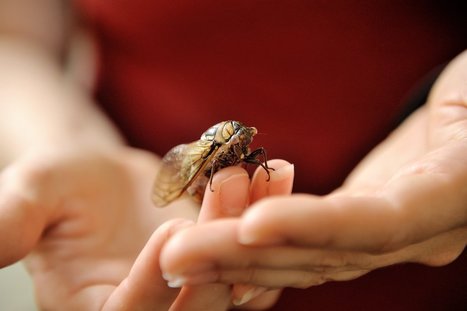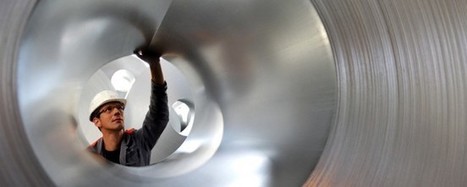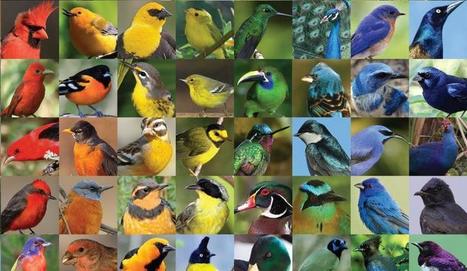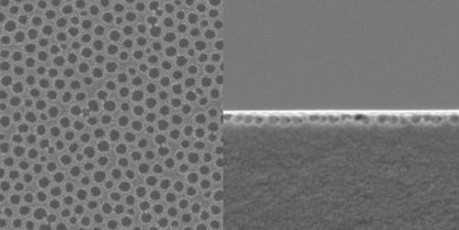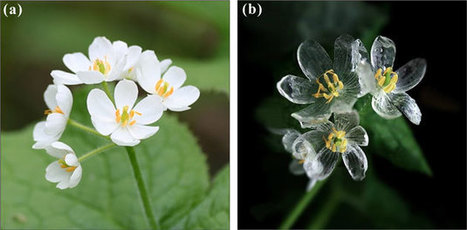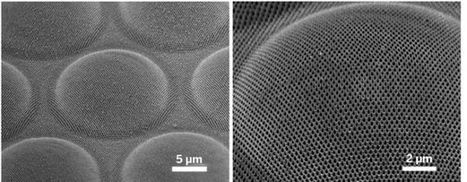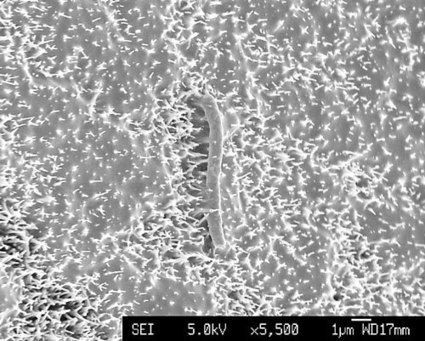 Your new post is loading...
 Your new post is loading...
"The sea urchin spines are mostly made of calcite, usually a very brittle and fragile material. In the case of the sea urchin, however, the spines are much more durable than the raw material alone. The reason for its strength is the way that nature optimises materials using a brick wall-style architecture. A research team headed by Prof. Helmut Colfen, successfully synthesised cement at the nano-level according to this "brick and mortar principle". During this process, macro-molecules were identified that take on the function of mortar, affixing the crystalline blocks to each other on the nano-scale, with the blocks assembling themselves in an ordered manner. The aim is to make cement more durable."
"Researchers are looking to insects – specifically cicadas – for insight into the design of artificial surfaces with de-icing, self-cleaning and anti-fogging abilities. Their wings allow cicadas to fly, of course, but they also are good at repelling water – a condition that humans can appreciate, too."
"Some water ferns can absorb large volumes of oil within a short time, because their leaves are strongly water-repellent and, at the same time, highly oil-absorbing. Researchers of KIT, together with colleagues of Bonn University, have found tha the oil-binding capacity of the water plant results from the hairy microstructure of its leaves. It is now used as a model to further develop the new Nanofur material for the environmentally friendly cleanup of oil spills."
"At least 40 species of tarantulas come in shades of blue. [...] To find out more about the "tarantula blue," researchers used different microscopy techniques to analyze tarantula hairs. They found that although these species share a shade of blue, tarantulas don't use pigments to produce it. Instead, the blue colors are produced thanks to nanostructures in the spiders' hair, which reflect blue light. And these nanostructures differ between species, the scientists found. Most importantly, however, these blue colors don’t change intensity or hue as the viewing angle changes. That's a big differentiator from the highly iridescent structural colors seen in most birds, butterflies, and beetles."
"The effect is known from the smart phone: Sun is reflected by the display and hardly anything can be seen. In contrast to this, the glasswing butterfly hardly reflects any light in spite of its transparent wings. As a result, it is difficult for predatory birds to track the butterfly during the flight. Researchers of KIT under the direction of Hendrik Hölscher found that irregular nanostructures on the surface of the butterfly wing cause the low reflection. In theoretical experiments, they succeeded in reproducing the effect that opens up fascinating application options, e.g. for displays of mobile phones or laptops."
"The rare blue morpho butterfly is among the largest butterflies in the world and one of the most spectacular with its brown wings that suddenly turn iridescent blue. This amazing display happens when blue light reflects off the layers of microscopic scales on its wings. 3M scientists studied the butterfly to mimic this effect in a window film."
"Used widely in nature, lamination – the deposition of fine layers of materials on top of one another – has long been known as a means of manufacturing stronger, more durable and longer lasting metals. Founded in 2006, Seattle’s Modumetal is applying the process of lamination at nano-scale, enabling engineers to design and fabricate metals with superior performance characteristics and at lower cost than conventional methods."
"..an MIT/Harvard study suggests that a specific type of limpet's shell may hold the key to transparent displays that require no internal light source. The mollusk in question is the blue-rayed limpet which, as its name implies, has bright blue stripes on its translucent shell. It is believed that these are used to make potential predators mistake it for a poisonous snail, which also has blue markings. The iridescent lines appear blue due to the fact that the shell material in those areas reflects the blue spectrum of incoming light, while absorbing other colors so that they don't drown out the blue."
"Sharks have tough skin that is worthy of biomimicry by nanotechnology designers and engineers. New coatings, textiles and other technologies that mimic the special biological properties of shark skin have been developed in recent years and many more such innovations are emerging across multiple industries."
"Moth eyeballs are made up of tiny cones that reduce glare. UC Irvine researchers copied the pattern on a new, flexible material and coated it with a bit of gold to make a product that could improve solar panels, LED displays and disguising of weapons."
"Earlier this year, we reported about a finding which revealed that physical structure of Psaltoda claripenniscicada wings can shred certain types of rod-shaped bacteria. After analyzing the surface, researchers at the Swinburne University of Technology used biomimicry to create a surface with similar properties. This nanosurface could lead to development of a new generation of nanostructured antibacterial materials. “Based on this discovery, we investigated other insects that may possess similar surface architectures that might kill more bacteria, in particular the deadly strains of the Staphylococcus aureus or golden staph bacterium”, said Elena Ivanova, microbiology professor at the Swinburne University of Technology. Their search led them to the wings of the Diplacodes bipunctata (Wandering Percher dragonfly), whose spike-like nanostructure destroys both rod-shaped and spherical bacteria."
"Butterfly wings can do remarkable things with light, and humans are still trying to learn from them. Physicists have now uncovered how subtle differences in the tiny crystals of butterfly wings create stunningly varied patterns of color even among closely related species. The discovery, reported today in the Optical Society's (OSA) open-access journal Optical Materials Express, could lead to new coatings for manufactured materials that could change color by design, if researchers can figure out how to replicate the wings' light-manipulating properties."
A new nanostructured material may lead to surfaces that stay dry forever, never need cleaning and are able to repel bacteria and even prevent mold and fungi growth. "The newly discovered material uses raspberry particles -- so-called because of their appearance -- which can trap tiny water droplets and prevent them from rolling off surfaces, even when that surface is turned upside down," said Dr Andrew Telford from the University's School of Chemistry and lead author of the research recently published in the journal, Chemistry of Materials. The raspberry particles mimic the surface structure of some rose petals.
|
Birds display a rainbow palette of colors, many of which come from special arrangements of melanin, the pigment that gives color to our skin. Researchers at the University of Akron have developed a safe and stable pigment based on the melanin structures.
Screens on even the newest phones and tablets can be hard to read outside in bright sunlight. Inspired by the nanostructures found on moth eyes, researchers led by Shin-Tson Wu of the University of Central Florida have developed a new antireflection film that could keep people from having to run to the shade to look at their mobile devices. The antireflection film exhibits a surface reflection of just 0.23 percent, much lower than the surface reflection of usual phones of 4.4 percent.
"UCL researchers have developed a revolutionary new type of ‘smart’ window which could cut window-cleaning costs in tall buildings while reducing heating bills and boosting worker productivity. The windows use nature inspired nanostructures which mimic the eyes of moths to cut glare, save energy and clean themselves."
"Inspired by the way iridescent bird feathers play with light, scientists have created thin films of material in a wide range of pure colors — from red to green — with hues determined by physical structure rather than pigments. Structural color arises from the interaction of light with materials that have patterns on a minute scale, which bend and reflect light to amplify some wavelengths and dampen others. Melanosomes, tiny packets of melanin found in the feathers, skin and fur of many animals, can produce structural color when packed into solid layers, as they are in the feathers of some birds. “We synthesized and assembled nanoparticles of a synthetic version of melanin to mimic the natural structures found in bird feathers,” said Nathan Gianneschi, a professor of chemistry and biochemistry at the University of California, San Diego. “We want to understand how nature uses materials like this, then to develop function that goes beyond what is possible in nature."
"Light scattering means that many synthetic oil-repellent surfaces are opaque, limiting their use. A transparent, oil-repellent surface would have applications in biology and underwater optics, including in diving goggles and cameras. Now, Feng Chen’s research group at Xi’an Jiaotong University has developed such a material. Fish repel oil by trapping water within their scales to create a self-cleaning, oil-repellent coat and prompted part of the idea behind the work. Chen’s other brainwave was triggered by Diphylleia grayi – also known as the skeleton flower."
"Researchers at the University of California at Berkeley announced today that they have developed an ultra-thin material that can change color on demand by bouncing back light on the nanoscale level. Well, the on-demand element is a little more nuanced. The “chameleon skin” material actually changes color when flexed, or when a small amount of force is applied to the surface."
"The eyes of nocturnal moths contain a series compound lenses: micro lenses called ommatidia which are themselves patterned with a nanoscale dome-shaped bumps. These structures naturally help reduce reflection of light at a wide range of wavelengths, enabling better night vision to help moths navigate in the dark. [...] The ability to capture light and not let go is appealing in the world of solar cells because it can increase efficiency. So the team from Singapore has taken inspiration from the complex lens structure to create a process that stamps patterns over the surface of a material, replicating the antireflective effects of the moths' eyes. "
"The spread of antimicrobial resistance with the emergence of 'super-bugs' that resist even 'last-resort' antibiotics has prompted the World Health Organisation (WHO) to formally tackle the problem of an unwanted post-antibiotic era. [...] A notable solution is provided by an unlikely source - the cicada.The wings of this small fly display bactericidal nanoscale pillar structures. Each of these pillars is a pike of several tens of nanometers in diameter and is separated from other pikes at regular nanometer intervals. Densely packed on the wing surfaces, these pillars arrange into nanopatterns which pierce the membranes of bacterial cells on contact, tearing bacteria apart. Inspired by this example, a research team from NPL and the School of Oral and Dental Sciences at the University of Bristol engineered biocompatible surfaces exhibiting nanowire arrays."
"In the Namib Desert of Africa, the fog-filled morning wind carries the drinking water for a beetle called the Stenocara. iny droplets collect on the beetle's bumpy back. The areas between the bumps are covered in a waxy substance that makes them water-repellant, or hydrophobic (water-fearing). Water accumulates on the water-loving, or hydrophilic, bumps, forming droplets that eventually grow too big to stay put, then roll down the waxy surface. [...] More than a decade ago, news of this creature's efficient water collection system inspired engineers to try and reproduce these surfaces in the lab. Small-scale advances in fluid physics, materials engineering and nanoscience since that time have brought them close to succeeding."
"Imitating nature is not a new idea. When the GE team put Morpho wings under a powerful microscope, they saw a layer of tiny scales just tens of micrometers across. In turn, each of the scales had arrays of ridges a few hundred nanometers wide. This complex structure absorbs and bends light and givesMorfo butterflies their trademark shimmering blue and green coat."
"US engineers have created the "most waterproof material ever" - inspired by nasturtium leaves and butterfly wings. The new "super-hydrophobic" surface could keep clothes dry and stop aircraft engines icing over, they say."
Norwegian researchers are using insights from the animal kingdom in their quest to design new self-cleansing and water-repellant surface materials.
|
 Your new post is loading...
Your new post is loading...
 Your new post is loading...
Your new post is loading...










